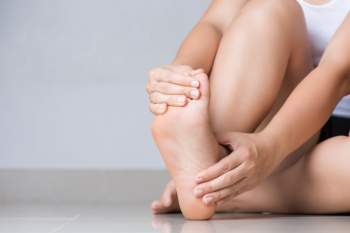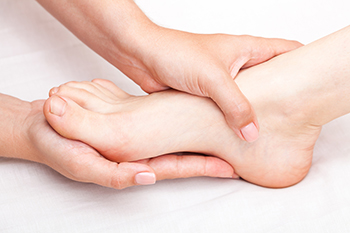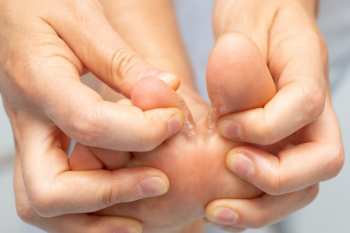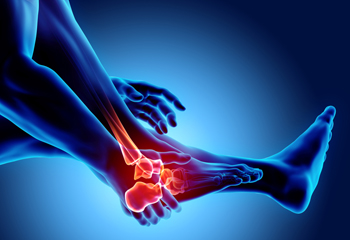
Stretching is not just beneficial for major muscle groups, but also for the often neglected toes, which play a vital role in maintaining balance and stability. Simple yet effective toe stretches can help alleviate discomfort, improve flexibility, and prevent common foot issues. Begin with the toe extension stretch by sitting comfortably and gently pulling each toe back, holding for a few seconds to feel the stretch along the top of the foot. Another beneficial stretch is the toe flexion stretch, where you sit and interlace your fingers between your toes, gently pressing them together to stretch the toe joints. Additionally, the toe spread exercise involves using your fingers to separate and stretch each toe outward, promoting better circulation and flexibility. If you are looking to learn about additional toe and foot stretches, it is suggested that you visit a podiatrist who can provide you with the knowledge you are seeking.
Stretching the feet is a great way to prevent injuries. If you have any concerns with your feet consult with Dr. Richard DiMario from Maine. Our doctor will assess your condition and provide you with quality foot and ankle treatment.
Stretching the Feet
Being the backbone of the body, the feet carry your entire weight and can easily become overexerted, causing cramps and pain. As with any body part, stretching your feet can serve many benefits. From increasing flexibility to even providing some pain relief, be sure to give your feet a stretch from time to time. This is especially important for athletes or anyone performing aerobic exercises, but anyone experiencing foot pain or is on their feet constantly should also engage in this practice.
Great ways to stretch your feet:
Individuals who tend to their feet by regular stretching every day should be able to minimize foot pain and prevent new problems from arising.
If you have any questions, please feel free to contact our office located in York, ME . We offer the newest diagnostic and treatment technologies for all your foot care needs.

A podiatrist specializes in treating foot, ankle, and lower limb conditions, providing care for ailments that can include fractures, nerve damage, and sports injuries. These doctors undergo extensive education, including a Doctor of Podiatric Medicine, or DPM, degree and residency training, focusing on lower extremity issues. Podiatrists diagnose and treat various conditions, from structural abnormalities to skin and nail disorders. Some podiatrists specialize in areas like orthotics, diabetes care, or surgery. They use diagnostic tools, such as imaging tests and sensory evaluations, to assess foot health accurately. Treatment options range from medication and injections to corrective footwear and surgery. Podiatrists are essential in managing foot-related issues. If you have a recent foot or ankle injury or are suffering with chronic discomfort in these areas, it is suggested that you schedule an appointment with a podiatrist for a proper diagnosis and treatment options.
If you are experiencing pain in the feet or ankles, don’t join the stubborn majority refusing treatment. Feel free to contact Dr. Richard DiMario from Maine. Our doctor can provide the care you need to keep you pain-free and on your feet.
What Is a Podiatrist?
Someone would seek the care of a podiatrist if they have suffered a foot injury or have common foot ailments such as heal spurs, bunions, arch problems, deformities, ingrown toenails, corns, foot and ankle problems, etc.
Podiatric Treatment
A podiatrist will treat the problematic areas of the feet, ankle or lower leg by prescribing the following:
A common podiatric procedure a podiatrist will use is a scanner or force plate which will allow the podiatrist to know the designs of orthotics. Patients are then told to follow a series of tasks to complete the treatment. The computer will scan the foot a see which areas show weight distribution and pressure points. The podiatrist will read the analysis and then determine which treatment plans are available.
If you have any questions please feel free to contact our office located in York, ME . We offer the newest diagnostic and treatment technologies for all your foot and ankle needs.

Athlete's foot, a common fungal infection, affects the skin of the feet and thrives in warm, damp environments such as sweaty socks and communal showers. The primary cause is the fungus trichophyton, which spreads through direct contact with contaminated surfaces or through contact with infected individuals. The signs and symptoms of athlete's foot vary, but often include itching, burning sensations, and redness between the toes or on the soles of the feet. In some cases, blisters or cracked skin may develop, leading to discomfort and pain. If left untreated, athlete's foot can spread to other areas of the body and cause secondary infections. Proper hygiene practices, such as keeping the feet clean and dry, wearing breathable footwear, and avoiding walking barefoot in public areas, may help to prevent athlete's foot. Early recognition and management are key to resolving athlete's foot and preventing its recurrence. If you have any of the above symptoms, it is strongly suggested that you visit a podiatrist as quickly as possible who can provide you with the necessary medication for relief and treatment.
Athlete’s Foot
Athlete’s foot is often an uncomfortable condition to experience. Thankfully, podiatrists specialize in treating athlete’s foot and offer the best treatment options. If you have any questions about athlete’s foot, consult with Dr. Richard DiMario from Maine. Our doctor will assess your condition and provide you with quality treatment.
What Is Athlete’s Foot?
Tinea pedis, more commonly known as athlete’s foot, is a non-serious and common fungal infection of the foot. Athlete’s foot is contagious and can be contracted by touching someone who has it or infected surfaces. The most common places contaminated by it are public showers, locker rooms, and swimming pools. Once contracted, it grows on feet that are left inside moist, dark, and warm shoes and socks.
Prevention
The most effective ways to prevent athlete’s foot include:
Symptoms
Athlete’s foot initially occurs as a rash between the toes. However, if left undiagnosed, it can spread to the sides and bottom of the feet, toenails, and if touched by hand, the hands themselves. Symptoms include:
Diagnosis and Treatment
Diagnosis is quick and easy. Skin samples will be taken and either viewed under a microscope or sent to a lab for testing. Sometimes, a podiatrist can diagnose it based on simply looking at it. Once confirmed, treatment options include oral and topical antifungal medications.
If you have any questions, please feel free to contact our office located in York, ME . We offer the newest diagnostic and treatment technologies for all your foot care needs.

Foot arthritis, a multifaceted condition, manifests in various ways, each presenting distinct challenges for those grappling with joint inflammation in the feet. Osteoarthritis, the most common form, results from wear and tear on the joints, causing pain and stiffness. Rheumatoid arthritis, an autoimmune disorder, targets the joints and may lead to deformities in the feet. Gout, characterized by the accumulation of uric acid crystals, induces sudden and severe pain. Recognizing the specific type of foot arthritis is essential for implementing targeted relief methods. While medications are common approaches to treatment, lifestyle modifications such as maintaining a healthy weight and choosing supportive footwear can help to alleviate symptoms. Resting the feet and engaging in gentle exercises can provide relief. Foot arthritis can cause discomfort, and if you are suffering from this condition, it is suggested that you visit a podiatrist who can guide you toward effective relief methods.
Arthritis can be a difficult condition to live with. If you are seeking treatment, contact Dr. Richard DiMario from Maine. Our doctor can provide the care you need to keep you pain-free and on your feet.
Arthritic Foot Care
Arthritis is a term that is commonly used to describe joint pain. The condition itself can occur to anyone of any age, race, or gender, and there are over 100 types of it. Nevertheless, arthritis is more commonly found in women compared to men, and it is also more prevalent in those who are overweight. The causes of arthritis vary depending on which type of arthritis you have. Osteoarthritis for example, is often caused by injury, while rheumatoid arthritis is caused by a misdirected immune system.
Symptoms
Arthritic symptoms range in severity, and they may come and go. Some symptoms stay the same for several years but could potentially get worse with time. Severe cases of arthritis can prevent its sufferers from performing daily activities and make walking difficult.
Risk Factors
If you suspect your arthritis is affecting your feet, it is crucial that you see a podiatrist immediately. Your doctor will be able to address your specific case and help you decide which treatment method is best for you.
If you have any questions, please feel free to contact our office located in York, ME . We offer the newest diagnostic and treatment technologies for all your foot care needs.